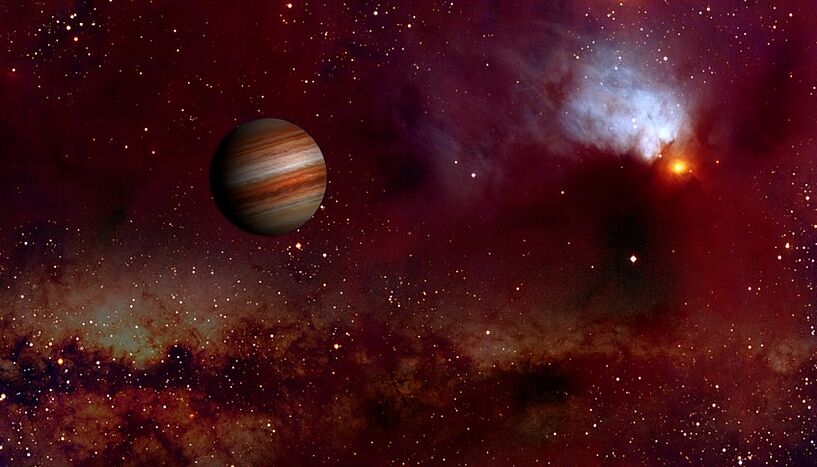Wandering celestial bodies provide a glimpse into the formation of stars and planets
23. Dezember 2021
Artist conception of a Jupiter-like free-floating planet in a star forming region. (© J.-C. Cuillandre, COSMIC-DANCe / CFHT / Gaia DPAC)
Discovery of hundreds of free-floating planets in our Galaxy
With observations of one of the closest star-forming regions to the sun a team of international astronomers discovered the largest population of free-floating planets. These celestial bodies do not revolve around a star and are very hard to find due to their very low brightness. The large number of planets now detected provides information about the formation process of stars and planets and important information for future research. Núria Miret Roig of the Institute of Astrophysics at the University of Vienna was involved in this exceptional discovery. The results were published in the journal Nature Astronomy.
The nature of free-floating planets (FFPs) is still mysterious. FFPs might originate in two ways: they either form on their own, like stars, through the gravitational collapse of small clouds of gas, or they form like planets around stars and then get stripped off from their stellar systems. Until now it was hard to investigate which formation mechanism is more likely, as a large homogenous sample of FFPs was missing. To answer this question, Núria Miret Roig and her collaborators targeted the Upper Scorpius young stellar association to search for these elusive planets. Star associations are open star clusters in which stars are no longer gravitationally bound to each other.
"Identifying FFPs within a star cluster is a major challenge, like finding a needle in the haystack", explains Miret Roig. "One needs eyes sensitive enough to detect the ‘needles’. Stars are relatively bright and easy to spot, whereas planets are several thousand times fainter and can only be detected with large aperture telescopes and sensitive detectors. An additional difficulty is to differentiate planets from the overwhelming multitude of field stars and background galaxies."
The team combined a vast amount of images available in public astronomical archives with new deep wide-field observations obtained with the best infrared and optical telescopes in the world. Thereby they were able to measure the tiny motions, colors, and luminosities of tens of millions of sources. To identify associations, the team first analyzed movement patterns of the sources, known as proper motions. The members of an association have similar proper motions, as they all originated from the same gas cloud, whereas objects unrelated to the association show random movement. After selecting possible association members by their motions, the team refined the selection by means of luminosities and colors, two characteristics that distinguish planets from stars and galaxies.
An important fraction of the images used for this study comes from the VISTA Star Formation Altas (VISIONS), a project led by Professor João Alves of the Department of Astrophysics of the University of Vienna. This atlas imaged in near-infrared all nearby star formation complexes identifiable from the Southern Hemisphere.
In total the team analyzed over 80 000 wide-field images taken over a span of twenty years and in addition around 100 terabytes of information. The result: 170 previously unknown FFPs, all members of the Upper Scorpius association. This is by far the largest sample of FFPs in a single association and almost doubles the total number of FFPs known to date.
"The large number of FFPs we found points to dynamical ejection from planetary systems as an important mechanism to their formation, as solely collapse from clouds would not result in so many FFPs. This result implies relatively short timescales, between 3 to 10 million years, for the formation of giant planet systems", explains Miret Roig.
Hervé Bouy, principal investigator of the European project within which this study is framed, emphasizes that "the FFPs that we identified are excellent targets for follow-up studies, in particular, to study planetary atmospheres in the absence of a blinding host star. Additionally, we can study the presence of gas and dust around FFPs, in what we call 'circumplanetary disks’, in order to shed light on their formation process."
If the fraction of FFPs found in Upper Scorpius is similar to that of other star forming regions, there could be several billions of planets with the size of Jupiter roaming the Milky Way without a host star. This number could be even greater for Earth-mass planets since they are known to be more common than massive planets.
This research is part of the ERC Consolidator program COSMIC-DANCE led by H. Bouy (University of Bordeaux) and is the main result of N. Miret Roig PhD’s thesis. This study has been possible thanks to the extensive use of data from ESO, NOAJ, NOAO, ING, VISIONS and from the ESA mission Gaia.
Publication in Nature Astronomy:
Núria Miret Roig (University of Vienna & Laboratoire d’Astrophysique de Bordeaux), Hervé Bouy, Sean N. Raymond, Javier Olivares, Phillip Galli (Laboratoire d’Astrophysique de Bordeaux), Motohide Tamura (Department of Astronomy of the University of Tokyo & Astrobiology Center, National Institutes of Natural Sciences), Emmanuel Bertin (CNRS & Sorbonne Université, Institut d’Astrophysique de Paris), David Barrado and Nuria Huélamo (Centro de Astrobiología (CSIC-INTA)), Jean-Charles Cuillandre (AIM, CEA, CNRS, Université Paris-Saclay), Luis Manuel Sarro (Depto. de Inteligencia Artificial, UNED), Angel Berihuete (Depto. Estad´ıstica e Investigación Operativa, Universidad de Cádiz): A rich population of free-floating planets in the Upper Scorpius young stellar association. In: Nature Astronomy, 2021.
Wissenschaftlicher Kontakt
Dr. MSc Núria Miret Roig
Institut für Astrophysik1180 - Wien, Türkenschanzstraße 17
+43-1-4277-51801
nuria.miret.roig@univie.ac.at
Dr. Anahí Caldú Primo
Institut für Astrophysik1180 - Wien, Türkenschanzstraße 17
+43-1-4277-53800
anahi.caldu@univie.ac.at
Rückfragehinweis
Mag. Alexandra Frey
Media Relations ManagerUniversität Wien
1010 - Wien, Universitätsring 1
+43-1-4277-17533
+43-664-8175675
alexandra.frey@univie.ac.at
Downloads:
FFP_C_J.-C._Cuillandre_COSMIC-DANCe_CFHT_Gaia_DPAC_01.jpg
Dateigröße: 71,63 KB
